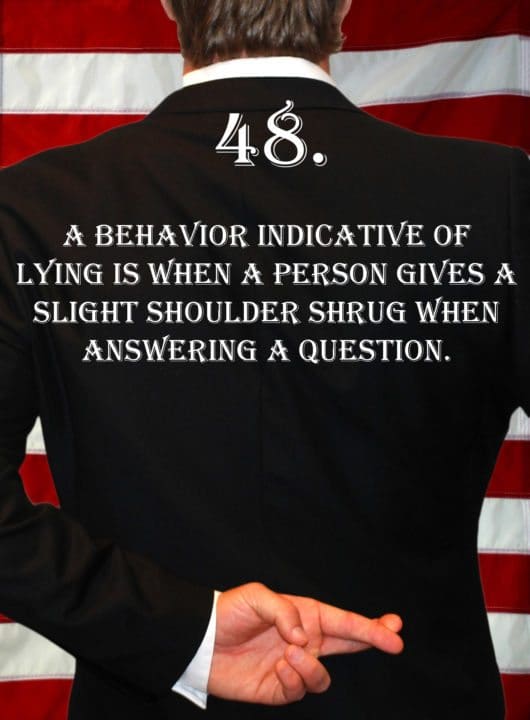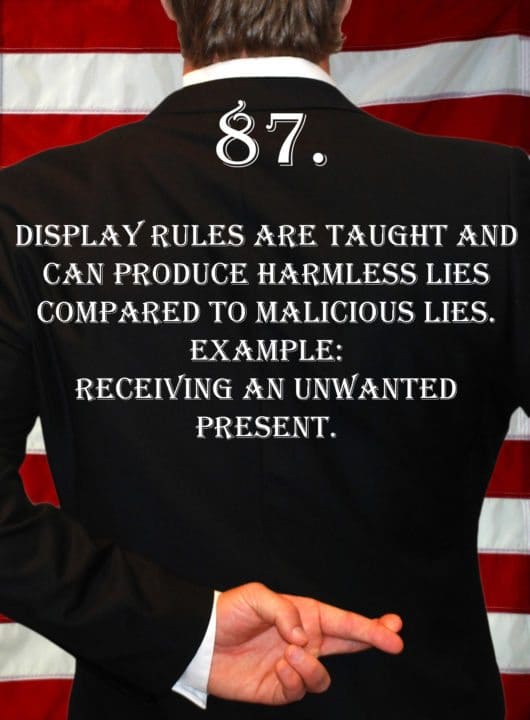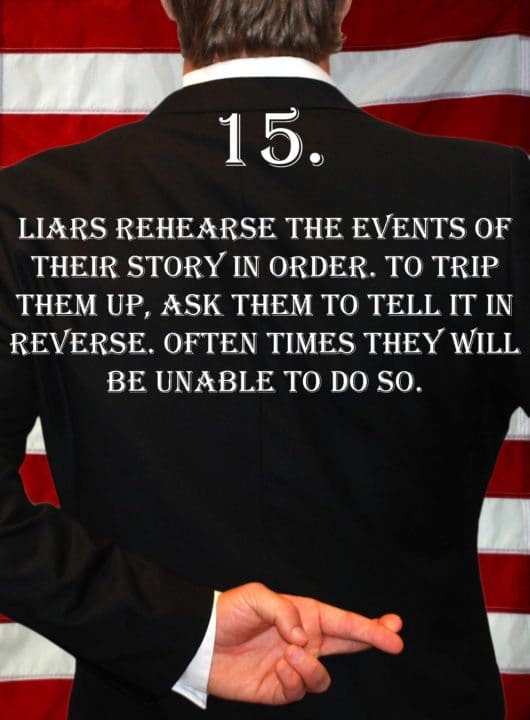
Deception Tip 48:
A behavior indicative of lying is when a person gives a slight shoulder shrug when answering a question.
Listen To The Podcast!
E48 – Slight Shoulder Shrug – Deception Tips Podcast – Click Here To Subscribe
Podcast Transcript
Hello and welcome to the deception tips podcast where you will learn amazing cues to detect deceit that will help you read people like never before. I’m your host Spencer Coffman, let’s get started.
Welcome to deception tip 48, this is a great podcast, thank you for listening. I really hope that you will share this with other people so that we can all get better at reading people and detecting deception.
In addition, if you could help me out, I would really appreciate it, I would like you to leave some reviews on iTunes or iHeart Radio, wherever you’re listening because that will also significantly help other people find this podcast.
It’s just like on Amazon when you’re looking to purchase a product and there are a ton of reviews and they’re all five stars, you’re like, “Wow, this is a pretty good product.” When there aren’t any reviews, you may be a little leery, if there are poor reviews, you’re definitely not going to buy it. Podcasts are the same way, so if you could take the time to leave a review, I would greatly appreciate it.
So, last week we talked about the legs and that is an area of the body that is super-expressive, and you can focus your attention there to see how other people are feeling. It’s important to note that this won’t be with only deception, you can watch people’s legs and see if they’re excited, if they’re interested in someone, they’re interested in something, the topic, where the legs are pointing.
You can see how they are responding to things such as when we talk about locked ankles way back in episode 22. You can also see what’s going on, a little preview, if their legs are pointed towards the exit or away from the conversation, they want out.
So, that’s a little bonus tip I’ll give you right there, we’ll probably talk about that in the future. Also, we’ve got how they bounce their legs, that could be a sign of anxiety or stress because they’re trying to release that.
In addition, depending on how the legs are bouncing or moving, it could show excitement. You watch the high school kids across the restaurant on a date and you’ll see one of them their legs are going nuts.
Remember that old game of footsie, people play footsie and that’s more of an excitement, or a passionate, type game that leads into something else or people hope it might lead to something else.
So, the legs are very expressive, and a lot of this stuff goes on under the table, which means it’s hidden, it’s behind the scenes. Therefore, if you can remove that table, it’s out in the open, you’ll be able to see this, and you can learn a lot more about what’s going on with the other people in the area or in the conversation. So, the legs are a significant area of body language.
Remember, the legs in terms of area, it’s a little less than half of the body, it’s almost half, that’s 50% of the body you’re not seeing if it’s behind a table, therefore, remove that table. Even though area-wise or volume-wise it’s about half, remember it’s not half of the expressions because the face has tons of expressions, and the arms are a ton more.
So, in terms of expression-wise, maybe it is only about 25% but still, that’s a quarter of the area or roughly around there. It’s still a good area for you to focus on because there are several signs on the legs that we’ve talked about and we will be talking about, therefore, pay attention to the leg.
Today, we’ve got a different sign, this is more of one that we’ve hinted at before, we’ve talked about different variations of this before way back in episode number three, when we talked about contradictory behaviors, how they’re not matching up. The behaviors aren’t incongruent, they’re different from the speech or the other patterns.
We also talked about them when we were in episode number 12, Simultaneous Gestures. We discussed how they need to be simultaneous with the speech. We have symmetrical expressions in episode 14, how the expressions on the face need to be symmetrical, so that means half the face needs to match the other half.
Like those old puzzles, you would see in the coloring books and they would have half of it on a grid paper and then you had to draw the other half and make it look symmetrical like a butterfly. We also talked about them in episode 16 with symmetrical gestures, meaning that on one side of the body and the other side of the body they need to match.
So, it’s not only the face that must be symmetrical, but it is also the body that must be symmetric. We also talked about it when we discussed all throughout this entire podcast how things must match, they must be congruent, they must be symmetrical, and they need to happen in synchronization with each other.
So, today we are going to talk about similar behavior, this is one specific case, when someone shrugs their shoulders, usually, they shrug both shoulders, however, this tip is when someone shrugs only one shoulder. So, here it is, this is deception tip number 48.
Behavior indicative of lying is when a person gives a slight shoulder shrug when answering a question. Here it is again, deception tip 48. Behavior indicative of lying is when a person gives a slight shoulder shrug when answering a question.
So, there’s a lot going on here, even though it sounds pretty simple, there are multiple facets to this, it is indicative of lying. Now, it doesn’t mean that they are outrightly, flat out telling a lie.
This could mean that they’re hiding something, it could mean that they don’t believe what they’re saying, or they are unsure of what they’re saying. For example, “Do you think the so and so football team will win this weekend?”
“Oh, yeah, I really believe they’re going to win”, shoulder shrugs on one side. Okay, well, they may not have the utmost confidence that they’ll win because the shoulder shrug means they may not believe it but that’s what they said. Was it a direct lie? No, because it’s something that hasn’t happened yet, so it’s more of a prediction that they don’t fully believe.
That also may happen when you ask someone a question about what they did, they may give you an answer. “How is your company doing?” “Oh, it’s great”, shoulder shrug. You don’t really believe it’s great, you’re worried about something. So, it’s just the fact that they might be hiding something, it means that they aren’t fully confident in whatever they’re saying, it’s not a direct lie.
Now, this is a slight shoulder shrug, so in the typical, “I don’t know” gesture such as when they shrug both shoulders, it’s really a big shrug, their shoulders go up to their ears almost. This is slight so it’s like a halfway perhaps, in addition, it’s usually asymmetrical. We’re going to dive a lot more into this and get into the different areas of it and what it might look like in some situations coming up after this.
Join the thousands of deception tips blog followers on Tumblr, and share your thoughts on the podcast, the videos, and the books. Find it today on tumblr.com.
Welcome back to deception tip 48, once again, we’re talking about slight shoulder shrugs and asymmetrical behaviors. Remember behaviors need to be symmetrical, that means on the face and the body and the gestures need to be symmetrical or congruent with the speech patterns. We’ve talked about this before, remember I cited one famous example a long time ago on Clinton.
How when he was pointing his finger and his speech wasn’t matching up, you can check out numerous examples on YouTube of that. Anyway, today, we are talking about the slight shoulder shrug that a person may display when answering some kind of question. It generally means that they are not confident, or they do not firmly believe whatever they are saying.
Therefore, if you ask a question such as “Hey, how is your company doing?” Or “How are the stock prices?” They may say, “Oh, they’re great” and then that one shoulder will go up. If you remember way back when we talked about how the different hemispheres of the brain control the opposite side of the body and one side is typically more active in deception than the other.
I’ll give you a little hint, perhaps you’ve been taking notes or something and you’re really into this and you’ve got a notebook or you’re listening to this at the same time that you’re reading through the deception tips e-book or something. This happened back in episode 23 when we really hammered on it, but it’s also been mentioned in a lot of the other episodes.
So, one side of the brain is more active in deception, if you remember which side that was, awesome, if not, don’t worry because it is the right side. The right side of the face is a little more active in deception than the other side. This is because the left side of the body or face is a little bit more expressive in deception.
I say a little bit more because it could depend on the person, it’s just a general statement or a general situation. When people are hooked up to cat scans, EEG, or something where they monitor your brain activity when telling lies, they’ve seen that it lights up more on the right side than the left side. Why? Well, some theories have stated because the right side is the creative side, it’s the more artistic side.
Typically, when you tell a lie, you have to be more creative, spontaneous, theatrical, stuff like that. Whereas the left side is more logical, mathematical, reasoning, and rules. If you’re more logical, mathematical, reasoning, rules, you’re going to probably follow the rules and tell more of the truth, that is why.
So, based on this, when a person gives that slight shoulder shrug, it would probably occur on the left side of the body because that would be the right brain controlling it. Keep in mind though, that this could be different, maybe someone is right-handed, so if they’re dominant with the right arm, they may give that slight shoulder shrug with the right arm.
So again, there could be exceptions to this but pay attention. Anytime you see it on one side of the body more than the other just automatically think something is wrong because it’s not symmetrical. You can move on further, poke for other behaviors, and remember you always need to watch for patterns and clusters of behavior.
You can never make a determination on one single sign of deception because if someone is lying there will always be more than one sign. For example, this one, just one shoulder goes up, remember a typical shoulder shrug if someone says I don’t know usually, there is a whole pattern of behaviors with that.
I don’t know, they may have their hands in their pockets, they may hunch their shoulders, they’re definitely going to shrug them. The shoulder will probably go up to about the earlobe, so it’s a big shoulder shrug, in addition, it will be both shoulders going up.
If their hands aren’t in their pockets already, they probably will put them in there eventually because it’s a cowering, they don’t know or their hands may turn upward like an offering, I don’t know. Remember when someone says hands up, Okay, my hands, here are my hands, I don’t have anything, they say, I don’t know, I don’t have an answer for you, so it’s all a big pattern or cluster.
Whereas this one, when it’s one side more than the other or it’s a slight shoulder shrug, it would typically be one-sided, and one hand might turn upward like I don’t really know. Well, they don’t have complete confidence in what they’re saying because if they did then they would be sure about it and both sides would go, both sides of the brain would be communicating together, and it would be a confident response.
Both hands may turn, both shoulders would shrug, both shoulders would hunch, etc. you would see it symmetrically across both sides of the body. So, when you see that one partial hand turn or a shoulder shrug, I don’t know or whatever they mean, or if they’re making a statement and their shoulder shrugs then guess what, they really don’t know.
So, you need to pay attention to that, anytime you see something that is asymmetrical continue to push for other signs of deception. These shoulder shrugs are very easy to spot, it is something that you can watch at any time. When you see them, whether it’s anything, if you’re watching someone else’s conversation, you could go up and say well, what were they talking about?
If you have an interest in anything if you’re at any business conferences or you’re trying to do business with someone. If you’re an attorney or a lawyer in court, someone is testifying, that would be a great cross. If they’re asking a question and you see that the person on the stand gives a shoulder shrug, boom, now you have a way in, you could tear them apart in the cross-examination.
Whatever they said, you know that they’re not very confident, you just need to figure out how to bring that out verbally so that the judge or the jury or whoever else can see it as well. So, this is something that you can definitely use to your advantage, you can definitely know about the confidence level that a person has when they’re speaking.
Remember it’s not necessarily a direct lying behavior, but you can use it to determine why they aren’t believing what they’re saying and see if maybe there is a lie going on about that or why they lied about it?
If they don’t believe it, why would they say they believe it? So, that is a lie, it’s not something huge but you can still push further and determine why they may not believe what they were saying, that is what is important.
Let’s say you’re making a purchase, you’re going to buy a car, you say, “Well, is it safe?” “Sure, it’s safe”, boom, slight shoulder shrug on half of the body, wait a minute, they don’t believe it’s safe. Why not? What happened?
You can dig into that a little bit more and get more information on that because it is very important that you are educated, especially when making a purchase such as a car. Especially if it’s for your kid, you need to know all of this stuff, so this is very important to pay attention to these slight shoulder shrugs.
I want to thank you for listening to the deception tips podcast, I hope that you’ll share it with your friends, subscribe to the feed, check out the deception tips videos, the deception tips blog, and also take a look at the books I have available and as always, tune in next week for a new deception tip.
Video Transcript
Hey guys, my name is Spencer Coffman, thank you for watching the deception tips videos, they’re all about teaching you how to read people and detect deception so that you will be able to tell if someone is lying to you. Today, we are going to talk about a cool tip that is related to specific areas of the body that it will just happen and things that you see will be a part of these signs.
Keep in mind that you are learning a lot more about all of the different areas of the body and the different signs that are happening. You’re putting together patterns and clusters of behavior so that you will be certain when someone is lying to you. No specific sign is good enough to be that comprehensive and that conclusive to tell you that someone is indeed telling a lie.
You need more support, there needs to be firm evidence that they are indeed lying. You can’t just go up to any single person and say, “Well, you folded your arms so you’re lying” or “You did this so you’re lying” or “You were bouncing your legs so you’re lying” or any of these other tips that we’ve covered. They aren’t conclusive enough, you need to watch for the patterns and clusters of behavior.
So, here it is, this is deception tip number 48. A behavior indicative of lying is when a person gives a slight shoulder shrug when answering a question. So, this one hopefully jogs your memory from one long ago about symmetrical gestures in deception tip number 16. This is a slight shoulder shrug which means it’s typically one shoulder, it would be one-sided, whether it’s one side or the other it’s not both, so the gesture isn’t symmetrical.
Now, what we learned about back then was that gestures when they’re truthful they are symmetrical. The reason being is because they are controlled by both sides of the brain and remember, the brain is contralaterally related to the body, so the right controls the left, the left controls the right, etc. When they’re communicating with each other properly and truthfully, you’ll see the gestures happen on both sides of the body.
If you’ve been watching the gestures that I’ve been doing in this video it’s with both hands and they happen at the same time. Notice when I said the word both my hands went together, so I was like both and it was symmetrical with the sides of the body and with the speech or congruent with speech. Speech and body language were symmetrical, congruent, simultaneous, all of those things, we’ve got a number of different tips with all of those different words.
So, that’s something to pay attention to because we’re talking about a slight shoulder shrug today, so it’s with one shoulder more than the other. This means that someone really doesn’t fully believe what they’re saying and they’re half confident. Think about what a shoulder shrug means, so if I ask you a question, “Where were you yesterday afternoon from 2:00 to 4:00 p.m.?
If you don’t know what are you going to do? Chances are I don’t know, you shrug your shoulders, when you shrug your shoulders, you’re shrugging them both, why do you shrug them both? It is because you don’t know, it’s the truth, you don’t know, you don’t know off the top of your head. Of course, you know, you just have to think about it and jog your memory and what you were doing and think about it.
It’s not right there on the tip of your tongue, you don’t know at that instant, so when you said you don’t know and you shrug both shoulders you really didn’t know, it was a truthful gesture. However, let’s say that you do know, you remembered but you just don’t want to tell them, you might say, “I don’t know” and you shrug one shoulder. In addition, remember that all of these behaviors and gestures it’s never just one sign when someone is lying.
The conscious and the unconscious are fighting, it’s a head-to-head battle. The unconscious is pushing all of these nonverbal and verbal signs of deception, this leakage out, the conscious is trying to stifle it, therefore, you’re going to see more than one sign. So, with this behavior, in particular, you may see that slight shoulder shrug, you may also see one hand go upward.
In a typical shoulder shrug, someone may shrug their shoulders and have both hands like, “I don’t know” and they’ll see both palms upward. In this particular tip, you may see one and the hand goes, and it’ll be the same side of the body, so if their right shoulder goes up the right hand may also go up. You may also see other tips or patterns, or clusters bundled in with that but keep in mind anything that you see that is not symmetrical or congruent it generally means something’s going on.
Something isn’t fully believed, whether they are halfway believing it or not it is half confidence in what they’re saying and that is what this tip means, they aren’t fully confident in the fact of whatever they’re saying. So, whether they’re saying they don’t know or whether they’re making a statement with that slight shoulder shrug it means they don’t fully believe whatever it is they are saying.
So, if this is your first time watching these videos, I’d love to have you subscribe to the channel on YouTube, feel free to comment with any questions you may have. Also, if you’d like more information, we’ve got books, blog posts, and podcasts all available on spencercoffman.com that are all dedicated to teaching you exactly what every body is saying.
Until next time.






